ICE 3
ICE 3, or Intercity-Express 3, is a family of high-speed electric multiple unit trains operated by Deutsche Bahn. It includes classes 403, 406 and 407, which are known as ICE 3, ICE 3M and New ICE 3 respectively. Four multisystem trains, known as ICE International, are owned by Nederlandse Spoorwegen (NS, Dutch Railways). Based on the ICE 3M/F, Siemens developed its Siemens Velaro train family with versions for Spain, China, Russia, its home country Germany, as well as the United Kingdom and Turkey.
| DB/NS Class 403/406/407 | |
|---|---|
 ICE 3 on the Cologne–Frankfurt high-speed rail line | |
| In service | 2000 – present |
| Manufacturer | Siemens |
| Family name | Velaro |
| Number built | 50 trainsets (ICE 3) 17 trainsets (ICE 3M/F) 17 trainsets on order (ICE Velaro D) |
| Formation | 8 passenger cars per halftrain, optional double traction giving 16 passenger cars |
| Capacity | 441 (ICE 3) 430 (ICE 3M) 460 (Velaro D) |
| Operator(s) | DB Fernverkehr Nederlandse Spoorwegen |
| Specifications | |
| Car body construction | Aluminum |
| Train length | trainset(8 cars) 200.84 m (658 ft 11 1⁄8 in) |
| Car length | 25.835 m (84 ft 9 1⁄8 in) (Cab car) 24.775 m (81 ft 3 3⁄8 in) (Intermediate car) |
| Width | 2.95 m (9 ft 8 1⁄8 in) (ICE 3/ICE 3M/Velaro D, Euro Spec) 3.265 m (10 ft 8 1⁄2 in) (CRH3, International option) |
| Height | 3.89 m (12 ft 9 1⁄8 in) |
| Maximum speed | 320 km/h (200 mph) (service) 330 km/h (210 mph) (design) |
| Weight | 409 t (403 long tons; 451 short tons) (ICE 3) 435 t (428 long tons; 480 short tons) (ICE 3M) |
| Power output | 8,000 kW (11,000 hp) |
| Tractive effort | 300 kN (67,000 lbf) Starting 270 kN (61,000 lbf) Cont. at 106 km/h (66 mph) |
| Power supply | (?) |
| Electric system(s) | 15 kV, 16.7 Hz AC 1.5 kV DC (ICE 3M) 3 kV DC (ICE 3M/Velaro D) 25 kV 50 Hz AC (ICE 3M/F/Velaro D) Overhead line |
| Current collection method | Pantograph |
| UIC classification | Bo′Bo′+2′2′+Bo′Bo′+2′2′ +2′2′+Bo′Bo′+2′2′+Bo′Bo′ (8 car set) |
| Safety system(s) | Sifa, PZB90, LZB (ICE 3) Sifa, PZB90, LZB80, Crocodile, TVM430, KVB, ATB, Eurobalise (ICE 3M) |
| Track gauge | 1,435 mm (4 ft 8 1⁄2 in) standard gauge |
Class 403
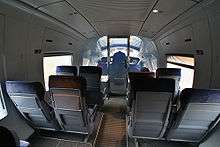
The design goal of the ICE 3 (Class 403) was to create a higher-powered, lighter train than its predecessors. This was achieved by distributing its 16 traction motors underneath the whole train. The train is licensed for 330 km/h (210 mph) and has reached 368 km/h (229 mph) on trial runs. On regular Intercity-Express services they run at up to 300 km/h (190 mph), the maximum design speed of German high-speed lines.
Because the train does not have power cars, the whole length of the train is available for passenger seats, including the first car. The lounge-seats are located directly behind the driver, separated only by a glass wall.
The 50 sets were ordered in 1997 and specifically designed for the new high-speed line between Frankfurt and Cologne. They were built by a consortium led by Siemens and Adtranz (now Bombardier Transportation).[1]
On 11 April 2017, Deutsche Bahn announced the modernisation programme called ICE 3 Redesign for its 66-unit ICE 3 fleet to be completed by the end of 2020.[2] The renovation involves replacing the seats, tables, and floor coverings. The six-seat compartment rooms are eliminated from the second class section as to increase the number of seats and to add more luggage compartments. In addition, the number of disability seating has been increased to two; however, no integrated wheelchair lift has been installed, and no disability seating is offered in the first class section. The seats in some Bordrestaurant have been converted to the red bench seating while Bordbistro receives the new stand tables. The cabin illumination is provided by LED lamps, providing more illumination, while the reading lamps are eliminated. The seat reservation panels are moved from the walls above the windows to the seat headrests per EU directive on accessibilities: the new panel has bigger and more visible white lettering and Braille. The yellow LCD information monitors in the antechambers are replaced with larger full-colour LED displays, showing the map, train number, speed, and other pertinent information. The new smaller displays are attached to the ceiling above the aisle throughout the cabins.
Class 406
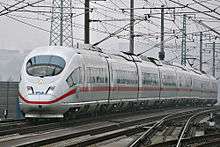
The ICE 3M (Class 406; M for multisystem) was developed to operate international services under the four different railway electrification systems in use on Europe's main lines and with support for various train protection systems. The Deutsche Bahn (DB) ordered 13 of these units in 1994, the NS (Nederlandse Spoorwegen) four, making sure that the demands of the Dutch rail network are taken care of. Though these trains carry NS logos, the DB and NS trains together form a pool and therefore, the NS trains may operate DB services as well. In 2007 the train was licensed for operation in the Netherlands, Belgium and France. Currently, those trains are used for cross-border runs between Netherlands, Germany, Belgium and France. On the French LGV Est, some trains reach a regular top speed of 320 km/h (199 mph).
The 17 class 406 sets were built by the same consortium as the class 403. They were first introduced from November 2000 on services between Cologne and Amsterdam. Since December 2002, they have also been operating three journeys daily each way between Frankfurt and Brussels (increased to four per day since December 2010).[1]
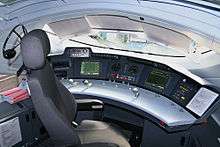
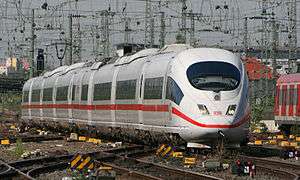
In Belgium, the train was licensed in 2002 to run on the classic 3 kV DC lines with speeds up to 160 km/h (99 mph) and, from December 2004, also on the new 25 kV AC high-speed lines, but initially limited to 250 km/h (160 mph) instead of 300 km/h (190 mph).[3] Problems with flying gravel and its frictionless linear eddy current brake came up during testing. In order to limit the creation of tornado-like vortices that pick up gravel and to limit damage from flying gravel to the train, spoilers have been added under the car joints, under the carbody next to the bogies and under the powered axles on the bogies.
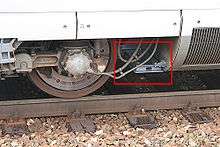
The linear eddy current brake, which is required for higher speeds, cannot yet be used, because the magnetic field would rip off the magnetic covers of some trackside equipment; those covers will have to be replaced by non-magnetic ones according to the EU Technical Specifications for Interoperability for international rail traffic in Europe.
As in Belgium, licensing procedures for France took five years to be completed. Trial runs were completed in late 2005 and the same two problems were encountered as in Belgium: loose gravel damage and possible side-effects of the brakes. ICE 3Ms were allowed on the LGV Est and started service there on 20 June 2007, mixed with TGVs. Since December 2007, DB operates ICE 3M trains from Frankfurt central station to Paris Est, initially with five daily runs between both cities. The six trains for running into France (designated ICE-3 MF, indicating multisystem France) were modified at Bombardier's Hennigsdorf plant and were extensively tested on Siemens' test site in Wegberg-Wildenrath before the modified trains re-entered commercial service.
Despite this, the "French" subset of six class 406 trains have suffered from reliability problems, so that some Paris–Frankfurt services are operated instead by French TGVs (currently TGV 2N2 'Euroduplex' as of 2015) under the "Alleo" joint venture between DB and SNCF.[1]
In Switzerland, licensing took only six months.[3]
Class 407

Deutsche Bahn placed an order for fifteen trains valued €500 million in November 2008.[4] On 18 April 2010, Deutsche Bahn presented the first Velaro D at Siemens' Krefeld plant.[5] It is designed for operation at up to 320 km/h (200 mph), is wider, quieter and more energy-saving, should be less susceptible to malfunctions than its predecessor, and incorporates additional crashworthiness and fire safety measures.[5] The new train was supposed to be used mainly for international services from Germany to France, Belgium and the Netherlands.[6] The new type's safety measures are in line with the new specifications for operating passenger trains inside the Channel Tunnel, allowing the Class 407 to be used on the services that DB planned to operate from London to Amsterdam and Frankfurt in 2015.[7] Delays to the delivery of the new trains led to the cancellation of the planned service to London.[8]
The new train is designated Class 407 or new ICE 3 and was originally scheduled to enter service at the end of 2011. This date has been since been postponed several times.[9] In December 2013 the first four trains delivered to DB were licensed for domestic operation as multiple units and started with passenger traffic. Four more trains are expected for delivery in spring 2014, whereas the remainder of eight trains shall be used by Siemens for test runs in France and Belgium to gain type approval there.[10]
In June 2011, Deutsche Bahn ordered an additional Velaro D set in order to replace an ICE3MF set damaged in an accident in August 2010.[11]
Special services
For the EXPO 2000 in Hanover, Deutsche Bahn provided 120 additional train services. Some of these special services were operated by ICE trains and labelled "ExpoExpress" (EXE). These services also constituted the first widespread use of the then-new ICE 3 train sets, presenting them to the domestic and international general public.[12]
See also
References
- "The German ICE family". Modern Railways. London. December 2010. pp. 70–71.
- "ICE 3 Redesign: Die Anpassungen im Überblick". 11 April 2017.
- Harmonisierungsdefizite am Beispiel von Auslandszulassungen des Triebzuges ICE 3, in "Elektrische Bahnen", Vo. 103 (2005), pages 147-149
- "Siemens receives order over 15 high-speed trains from Deutsche Bahn" (Press release). Siemens. 17 December 2008. Archived from the original on 16 February 2012. Retrieved 27 December 2008. Reference Number: I MO 200812.006-04.
- "DB unveils next-generation ICE". Railway Gazette International. London. 28 April 2010. Retrieved 4 May 2010.
- "Neuer ICE: Hightech gegen die Achsenkrise". Spiegel Online (in German). 28 April 2010. Retrieved 28 April 2010.
- Fender, Keith (December 2010). "DB unveils plans for London services". Modern Railways. London. pp. 68–69.
- "Germany's Frankfurt-London high-speed rail link put on ice". February 2014. Retrieved 21 February 2014.
- Keith Barrow (14 June 2013). "DB secures Channel Tunnel access". International Railway Journal.
- "EBA approves Velaro D high speed trains for domestic operation". Railway Gazette International. London. 23 December 2013.
- Smith, Kevin (June 2011). "DB and Siemens finally sign ICx contract". International Railway Journal. Falmouth. p. 4.
- "Dritte Generation ICE-Triebzüge für DB Reise&Touristik". Elektrische Bahnen, Elektrotechnik im Verkehrswesen (in German) (11). 2000. ISSN 0013-5437.
External links
| Wikimedia Commons has media related to ICE 3. |
- ICE 3 for Germany and the Netherlands Siemens Page
- Spec Sheet; French